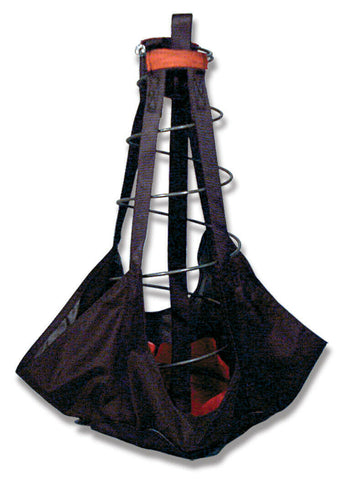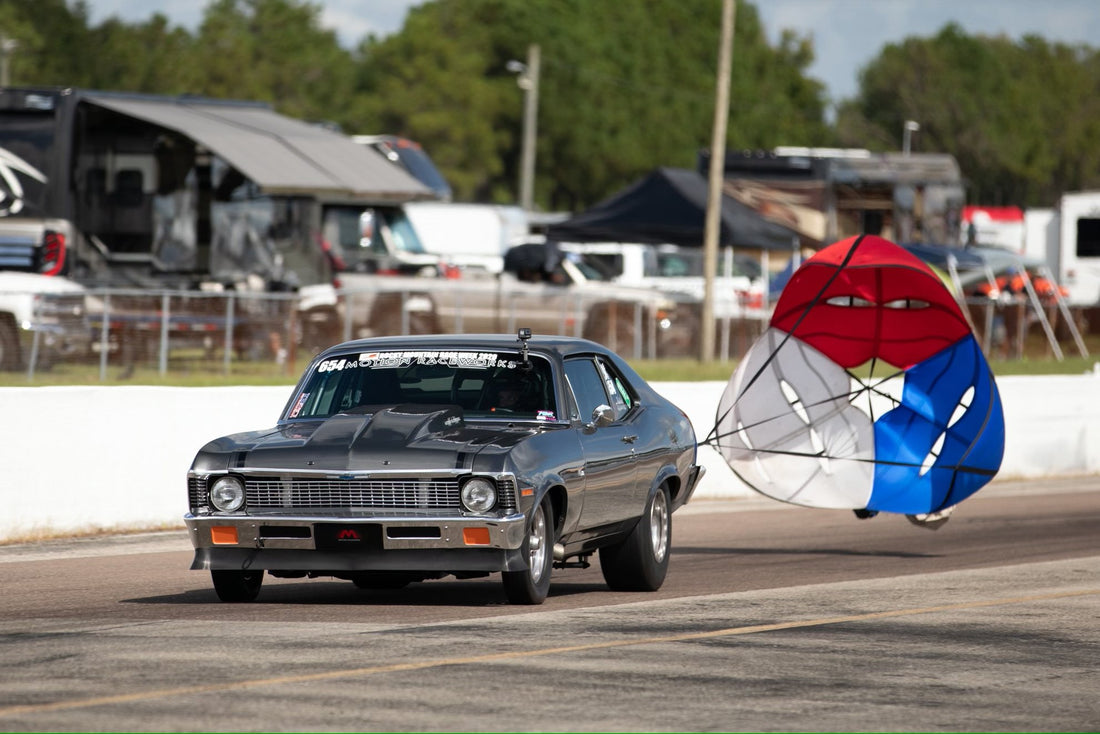Parachutes on a drag racing car can be a daunting and confusing topic for a first timer. Size of parachute, which style, deployment method, which brand, accessories such as release handle, cable and more all seem to have a lot of options that can be overwhelming.
This Blog is intended to answer those questions, so here we go!
Parachutes:
Not all parachutes are created equal. Some are small, some are large, some hit HARD, some hit soft, you will see cars with single, some with dual, and all different brands shapes and sizes.
The simple answer is to consult your local parts supplier or chassis builder. Though I will fill you in on some info below.
We have always used Stroud Safety. Early on we learned and realized that a HARD hitting parachute is a dangerous parachute. While you want something that stops quickly you do not want it to upset the chassis. A hard hitting parachute that opens high for instance can lift the back of the car off the ground, and at 150+ MPH that is just pure dangerous, it often ends badly. We have found that Stroud parachutes deploy lower and open softer but still give you excellent stopping capabilities.
Parachute Styles
- Pilot Spring: This style parachute essentially is a parachute with a miniature spring loaded parachute (pictured below) that gets packed on top. The mini spring parachute ejects when the cable is pulled. When the mini parachute catches air it pulls the main parachute out and everything blossoms. These are the most cost effective and also the slowest deploying option, though these are suitable for basically any car or application, the lightest weight option, and most reliable. A ddrawback for a spring pilot parachute is that a vehicle without good air flow or that has a weird flow pattern may not actually catch air and therefore will not deploy the parachute. Examples of vehicles like this might be Blazers, convertibles/roadsters, etc. Other drawbacks include the spring pilot will wear out from dragging on the ground and does need to be replaced periodically as it tears.

- Air Launcher: This is essentially a pneumatic ram behind the main parachute that is operated with CO2 (or can be operated with another inert gas) at 150 PSI. There is an arming switch that you flip before you head down the track and that essentially arms the parachute. Meaning that all of the pressure is being applied and is just waiting for the cable to be removed to complete its outward push. You'll note that air launcher bags on cars are extremely tight and look like they're going to explode if and when the car is in the lanes. Air launcher parachutes have the fastest and quickest deployment. From the moment you release the parachute cable, it is fully blossomed in the least amount of time. The draw back is the overall length of the parachute, as well as the need for onboard CO2. Another notable item is that some cars with dead areas / bad aerodynamics out back need an air launcher.

- Spring Cannister: The Spring Cannister is the most unsightly version of a parachute, and somewhat inconvenient to "wind up" but is called the most reliable option. These big silver cannister launchers offer fast deployment as seen by an air launcher, but do not require CO2, the other benefit of this is that the pilot spring does not tear and wear out as the spring is BEHIND the parachute. The drawback to these is that you have to crank the spring back into the cannister, they're very large and the most heavy option, additionally they require the parachute to be spaced out further.

In the end of the day, different styles of parachutes work better or worse depending on the situations described above. If you have a question about your setup, we are always happy to consult. Give us a call during working hours (800) 878-9274 or Text us at (563) 202-6015.
To shop parachutes click here: https://www.motionraceworks.com/collections/parachute-systems
Release handles
Release handles are relatively simple. Your push a handle, it operates a morse style cable, in turn removing the cable from the loop on the parachute pack which allows the parachute to deploy. The only difference in handles is there are manually operated handles, as well as CO2 activated handles. CO2 activated handles are essentially operated with a pneumatic ram so that you can push a button, a solenoid charges the ram, the ram pushes the handle. This allows you to deploy the parachute with your hands on the wheel. See the two styles below in pictures. (NOTE: you can operate the co2 handle manually in the event of an emergency or loss of co2).
Placement, you will want to place the parachute handle in a place where you can get to it without reaching or without much effort while going 150-200+ mph. It needs to be a natural motion to release the parachute handle as sometimes it is just a normal deployment, other times its an oh sh*t situation that can be the difference in the car stopping safely and not.


To order parachute handles click here: https://www.motionraceworks.com/collections/parachute-levers-mounts
Accessories
There are a few accessories for parachutes that are a MUST HAVE!
Parachute cable holder: This clamps the parachute cable so that when pushing the handle release, the inner cable slides in and out, otherwise there is a chance the whole cable flexes without properly deploying/releasing the inner wire. Click Here
Parachute Billet End Cap: This screws on to the end of the cable to protect the wires from snagging the parachute which in turn prevents the parachute from deploying. This 9$ part can be the most important piece of safety equipment on your ride! Click Here

Color
Believe it or not, Black seems to be the best parachute color, though we are a little partial to our red, white and blue "Merica" parachute pattern. Because these parachutes are getting deployed and then drug across asphalt and pavement that may have oil and grease and dirt from blown engines etc, parachutes seem to only last a few days at the track before becoming dingy. Black is just a good neutral color that looks good and matches everyones car. Just following Henry Ford's lead here.
More helpful links!
Learn how to trim your parachute cable after installation, properly by watching this video.
Learn how to pack a parachute for the first time
